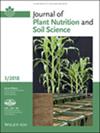Magnitude and driving factors of boron depletion in agricultural soils
IF 2.8
3区 农林科学
Q1 AGRONOMY
引用次数: 0
Abstract
BackgroundNeither the magnitude of boron (B) depletion in agricultural soils nor the driving factors of this process have been systematically studied before.AimsThe objectives of our study were to survey the extractable B (B农业土壤中硼耗尽的程度和驱动因素
研究目的我们的研究目标是调查原始土壤与耕作土壤中的可提取硼(Be)含量,估算农业生态系统中每年的硼损耗率,并确定决定该损耗率的环境、生产和/或气候因素。方法分别于 2011 年和 2018 年(AGR2011 和 AGR2018)在阿根廷潘帕斯草原的未种植(UC)地块和附近农田采集表层土壤样本(0-20 厘米层)。在这些样本中,测定了铍及其他气候和生产变量,如粘土含量、降水量(PP)、pH值、蒸散量(ET)、土壤有机质(SOM)以及作物颗粒对铍的去除量(RB)。结果铍浓度随着农业活动而降低,因为UC土壤的平均铍值为1.9毫克/千克,而AGR2011和AGR2018土壤的铍值分别为1.3和0.9毫克/千克。从2018年到2011年,硼的消耗率在0.01到0.06毫克千克-1年-1之间,与这一过程相关的主要因素是RB、PP、土壤酸化和SOM消耗(促进硼的消耗)以及ET和粘土(减少消耗)。结论按照目前的速度,这些农业土壤的硼消耗可能会在中短期内影响作物对硼的可用性,这取决于由气候和生产力差异(RB、PP、pH值、SOM、ET和粘土)造成的地区差异。需要采取紧急行动来阻止和/或恢复这一土壤退化过程。
本文章由计算机程序翻译,如有差异,请以英文原文为准。
求助全文
约1分钟内获得全文
求助全文
来源期刊
CiteScore
4.70
自引率
8.00%
发文量
90
审稿时长
8-16 weeks
期刊介绍:
Established in 1922, the Journal of Plant Nutrition and Soil Science (JPNSS) is an international peer-reviewed journal devoted to cover the entire spectrum of plant nutrition and soil science from different scale units, e.g. agroecosystem to natural systems. With its wide scope and focus on soil-plant interactions, JPNSS is one of the leading journals on this topic. Articles in JPNSS include reviews, high-standard original papers, and short communications and represent challenging research of international significance. The Journal of Plant Nutrition and Soil Science is one of the world’s oldest journals. You can trust in a peer-reviewed journal that has been established in the plant and soil science community for almost 100 years.
Journal of Plant Nutrition and Soil Science (ISSN 1436-8730) is published in six volumes per year, by the German Societies of Plant Nutrition (DGP) and Soil Science (DBG). Furthermore, the Journal of Plant Nutrition and Soil Science (JPNSS) is a Cooperating Journal of the International Union of Soil Science (IUSS). The journal is produced by Wiley-VCH.
Topical Divisions of the Journal of Plant Nutrition and Soil Science that are receiving increasing attention are:
JPNSS – Topical Divisions
Special timely focus in interdisciplinarity:
- sustainability & critical zone science.
Soil-Plant Interactions:
- rhizosphere science & soil ecology
- pollutant cycling & plant-soil protection
- land use & climate change.
Soil Science:
- soil chemistry & soil physics
- soil biology & biogeochemistry
- soil genesis & mineralogy.
Plant Nutrition:
- plant nutritional physiology
- nutrient dynamics & soil fertility
- ecophysiological aspects of plant nutrition.

 求助内容:
求助内容: 应助结果提醒方式:
应助结果提醒方式:


